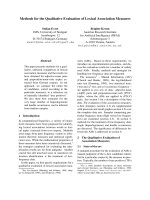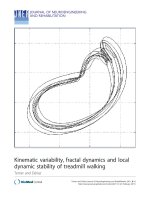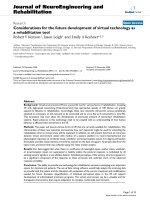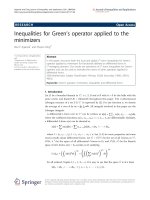Báo cáo hóa học: "INEQUALITIES INVOLVING THE MEAN AND THE STANDARD DEVIATION OF NONNEGATIVE REAL NUMBERS" doc
Bạn đang xem bản rút gọn của tài liệu. Xem và tải ngay bản đầy đủ của tài liệu tại đây (547.64 KB, 15 trang )
INEQUALITIES INVOLVING THE MEAN AND
THE STANDARD DEVIATION OF NONNEGATIVE
REAL NUMBERS
OSCAR ROJO
Received 22 December 2005; Revised 18 August 2006; Accepted 21 Septe mber 2006
Let m(y)
=
n
j
=1
y
j
/n and s(y) =
m(y
2
) −m
2
(y) be the mean and the standard deviation
of the components of the vector y
= (y
1
, y
2
, , y
n−1
, y
n
), where y
q
= (y
q
1
, y
q
2
, , y
q
n
−1
, y
q
n
)
with q a positive integer. Here, we prove that if y
≥ 0,thenm(y
2
p
)+(1/
√
n −1)s(y
2
p
) ≤
m(y
2
p+1
)+(1/
√
n −1)s(y
2
p+1
)forp = 0,1,2, The equality holds if and only if
the (n
− 1) largest components of y are equal. It follows that (l
2
p
(y))
∞
p=0
, l
2
p
(y) =
(m(y
2
p
)+(1/
√
n −1)s(y
2
p
))
2
−p
, is a strictly increasing sequence converging to y
1
,the
largest component of y,exceptifthe(n
−1) largest components of y are equal. In this
case, l
2
p
(y) = y
1
for all p.
Copyright © 2006 Oscar Rojo. This is an op en access article distributed under the Cre-
ative Commons Attribution License, which permits unrestricted use, distribution, and
reproduction in any medium, provided the original work is properly cited.
1. Introduction
Let
m(x)
=
n
j
=1
x
j
n
, s(x)
=
m
x
2
−
m
2
(x) (1.1)
be the mean and the standard deviation of the components of x
= (x
1
,x
2
, , x
n−1
,x
n
),
where x
q
= (x
q
1
,x
q
2
, , x
q
n
−1
,x
q
n
) for a positive integer q.
The following theorem is due to Wolkowicz and Styan [3, Theorem 2.1.].
Theorem 1.1. Let
x
1
≥ x
2
≥···≥x
n−1
≥ x
n
. (1.2)
Hindawi Publishing Corporation
Journal of Inequalities and Applications
Volume 2006, Article ID 43465, Pages 1–15
DOI 10.1155/JIA/2006/43465
2 Inequalities on the mean and standard deviation
Then
m(x)+
1
√
n −1
s(x)
≤ x
1
, (1.3)
x
1
≤ m(x)+
√
n −1s(x). (1.4)
Equality holds in ( 1.3)ifandonlyifx
1
= x
2
=···=x
n−1
. Equality holds in (1.4)ifandonly
if x
2
= x
3
=···=x
n
.
Let x
1
,x
2
, ,x
n−1
,x
n
be complex numbers such that x
1
is a positive real number and
x
1
≥
x
2
≥···≥
x
n−1
≥
x
n
. (1.5)
Then,
x
p
1
≥
x
2
p
≥···≥
x
n−1
p
≥
x
n
p
(1.6)
for any positive integer p.WeapplyTheorem 1.1 to (1.6)toobtain
m
|
x|
p
+
1
√
n −1
s
|
x|
p
≤
x
p
1
,
x
p
1
≤ m
|
x|
p
+
√
n −1s
|
x|
p
,
(1.7)
where
|x|=(|x
1
|,|x
2
|, , |x
n−1
|,|x
n
|).
Then,
l
p
(x) =
m
|
x|
p
+
1
√
n −1
s
|
x|
p
1/p
(1.8)
isasequenceoflowerboundsforx
1
and
u
p
(x) =
m
|
x|
p
+
√
n −1s
|
x|
p
1/p
(1.9)
isasequenceofupperboundsforx
1
.
We recall that the p-norm and the infinity-norm of a vector x
= (x
1
,x
2
, , x
n
)are
x
p
=
n
i=1
x
i
p
1/p
,1≤ p<∞,
x
∞
= max
i
x
i
.
(1.10)
It is well known that lim
p→∞
x
p
=x
∞
.
Oscar Rojo 3
Then,
l
p
(x) =
⎛
⎜
⎝
x
p
p
n
+
1
n(n −1)
x
2p
2p
−
x
2p
p
n
⎞
⎟
⎠
1/p
,
u
p
(x) =
⎛
⎜
⎝
x
p
p
n
+
n −1
n
x
2p
2p
−
x
2p
p
n
⎞
⎟
⎠
1/p
.
(1.11)
In [2, Theorem 11], we proved that if y
1
≥ y
2
≥ y
3
≥···≥y
n
≥ 0, then
m
y
2
p
+
√
n −1s
y
2
p
≥
m
y
2
p+1
+
√
n −1s
y
2
p+1
(1.12)
for p
= 0,1,2, The equality holds if and only if y
2
= y
3
=···=y
n
. Using this inequal-
ity, we proved in [2, Theorems 14 and 15] that if y
2
= y
3
=···=y
n
,thenu
p
(y) = y
1
for all p,andify
i
<y
j
for some 2 ≤ j<i≤ n,then(u
2
p
(y))
∞
p=0
is a strictly decreasing
sequence converging to y
1
.
The main purpose of this paper is to prove that if y
1
≥ y
2
≥ y
3
≥···≥y
n
≥ 0, then
m
y
2
p
+
1
√
n −1
s
y
2
p
≤
m
y
2
p+1
+
1
√
n −1
s
y
2
p+1
(1.13)
for p
= 0,1,2, The equality holds if and only if y
1
= y
2
=···=y
n−1
. Using this in-
equality, we prove that if y
1
= y
2
=···=y
n−1
,thenu
p
(y) = y
1
for all p,andify
i
<y
j
for
some 1
≤ j<i≤ n −1, then (l
2
p
(y))
∞
p=0
is a strictly increasing sequence converging to y
1
.
2. New inequalities involving m(x) and s(x)
Theorem 2.1. Let x
= (x
1
,x
2
, , x
n−1
,x
n
) be a vector of complex numbers s uch that x
1
is a
positive real number and
x
1
≥
x
2
≥···≥
x
n−1
≥
x
n
. (2.1)
The sequence (l
p
(x))
∞
p=1
converges to x
1
.
Proof. From (1.11),
l
p
(x) ≥
x
p
p
√
n
∀p. (2.2)
Then, 0
≤|l
p
(x) −x
1
|=x
1
−l
p
(x) ≤ x
1
−x
p
/
p
√
n for all p.Sincelim
p→∞
x
p
= x
1
and lim
p→∞
p
√
n=1, it follows that the sequence (l
p
(x)) converges and lim
p→∞
l
p
(x) =x
1
.
We introduce the following notations:
(i) e
=(1,1, ,1),
(ii) Ᏸ
= R
n
−{λe :λ ∈ R},
(iii) Ꮿ
={x =(x
1
,x
2
, , x
n
):0≤ x
k
≤ 1, k = 1,2, ,n},
4 Inequalities on the mean and standard deviation
(iv) Ᏹ
={x =(1,x
2
, , x
n
):0≤ x
n
≤ x
n−1
≤···≤x
2
≤ 1},
(v)
x,y=
n
k
=1
x
k
y
k
for x,y ∈ R
n
,
(vi)
∇g(x) =(∂
1
g(x),∂
2
g(x), ,∂
n
g(x)) denotes the gradient of a differentiable func-
tion g at the point x,where∂
k
g(x) is the partial derivative of g with respect to x
k
,
evaluated at x.
Clearly, if x
∈ Ᏹ,thenx
q
∈ Ᏹ with q a positive integer.
Let v
1
,v
2
, ,v
n
be the points
v
1
= (1,0, ,0),
v
2
= (1,1,0, ,0),
v
3
= (1,1,1,0, ,0),
.
.
.
v
n−2
= (1,1, ,1,0,0),
v
n−1
= (1,1, ,1,1,0),
v
n
= (1,1, ,1,1) =e.
(2.3)
Observe that v
1
,v
2
, , v
n
lie in Ᏹ.Foranyx =(1,x
2
,x
3
, ,x
n−1
,x
n
) ∈Ᏹ,wehave
x
=
1 −x
2
v
1
+
x
2
−x
3
v
2
+
x
3
−x
4
v
3
+ ···+
x
n−2
−x
n−1
v
n−2
+
x
n−1
−x
n
v
n−1
+ x
n
v
n
.
(2.4)
Therefore, Ᏹ is a convex set. We define the function
f (x)
= m(x)+
1
√
n −1
s(x), (2.5)
where x
= (x
1
,x
2
, , x
n
) ∈R
n
.Weobservethat
ns
2
(x) =
n
k=1
x
2
k
−
n
j
=1
x
j
2
n
=
n
k=1
x
k
−m(x)
2
=
x−m(x)e
2
2
.
(2.6)
Then,
f (x)
= m(x)+
1
n(n −1)
x−m(x)e
2
=
n
j
=1
x
j
n
+
1
n(n −1)
n
k=1
x
2
k
−
n
j
=1
x
j
2
n
.
(2.7)
Next, we give properties of f . Some of the proofs are similar to those in [2].
Oscar Rojo 5
Lemma 2.2. The function f has continuous first partial derivatives on Ᏸ,andforx
=
(x
1
,x
2
, , x
n
) ∈Ᏸ and 1 ≤k ≤ n,
∂
k
f (x) =
1
n
+
1
n(n −1)
x
k
−m(x)
f (x) −m(x)
, (2.8)
n
k=1
∂
k
f (x) =1, (2.9)
∇
f (x),x
=
f (x). (2.10)
Proof. From (2.7), it is clear that f is differentiable at every point x
= m(x )e,andfor
1
≤ k ≤n,
∂
k
f (x) =
1
n
+
1
n(n −1)
x
k
−
n
j
=1
x
j
/n
n
i
=1
x
2
i
−
n
j
=1
x
j
2
/n
=
1
n
+
1
n(n −1)
x
k
−m(x)
f (x) −m(x)
,
(2.11)
which is a continuous function on Ᏸ. Then,
n
k
=1
∂
k
f (x) =1. Finally,
∇
f (x),x
=
n
k=1
x
k
∂
k
f (x)
=
n
k
=1
x
k
n
+
1
n(n −1)
n
k
=1
x
2
k
−m(x)
n
k
=1
x
k
f (x) −m(x)
= m(x)+
1
n(n −1)
x −a(x)e
2
= f (x).
(2.12)
This completes the proof.
Lemma 2.3. The function f is convex on Ꮿ.Moreprecisely,forx,y ∈ Ꮿ and t ∈[0,1],
f
(1 −t)x + ty
≤
(1 −t) f (x)+tf(y) (2.13)
with equality if and only if
x
−m(x)e =α
y −m(y)e
(2.14)
for some α
≥ 0.
Proof. Clearly Ꮿ is a convex set. Let x, y
∈ Ꮿ and t ∈[0,1]. Then,
f
(1 −t)x + ty
=
m
(1 −t)x + ty
+
1
n(n −1)
(1 −t)x + ty −m
(1 −t)x + ty
e
2
=(1−t)m(x)+tm(y )+
1
n(n−1)
(1−t)
x−m(x)e
+t
y−m(y)e
2
.
(2.15)
6 Inequalities on the mean and standard deviation
Moreover ,
(1 −t)
x −m(x)e
+ t
y −m(y)e
2
2
= (1 −t)
2
x −m(x)e
2
2
+2(1−t)t
x −m(x)e,y −m(y)e
+ t
2
y −m(y)e
2
2
.
(2.16)
We recall the Cauchy-Schwarz inequality to obtain
x −m(x)e,y −m(y)e
≤
x −m(x)e
2
y −m(y)e
2
(2.17)
with equality if and only if (2.14)holds.Thus,
(1 −t)
x −m(x)e
+ t
y −m(y)e
2
≤ (1−t)
x −m(x)e
2
+ t
y −m(y)e
2
(2.18)
with equality if and only if (2.14)holds.Finally,from(2.15)and(2.18), the lemma fol-
lows.
Lemma 2.4. For x,y ∈ Ᏹ −{e},
f (x)
≥
∇f (y),x
(2.19)
with equality if and only if (2.14) holds for some α>0.
Proof. Ᏹ isaconvexsubsetofᏯ and f isaconvexfunctiononᏱ.Moreover, f isadiffer-
entiable function on Ᏹ
−{e}.Letx,y ∈ Ᏹ −{e}.Forallt ∈[0, 1],
f
tx+(1 −t)y
≤
tf(x)+(1−t) f (y). (2.20)
Thus, for 0 <t
≤ 1,
f
y + t(x −y)
−
f (y)
t
≤ f (x) − f (y). (2.21)
Letting t
→ 0
+
yields
lim
t→0
+
f
y + t(x −y)
−
f (y)
t
=
∇
f (y),x −y
≤
f (x) − f (y). (2.22)
Hence,
f (x)
− f (y) ≥
∇f (y),x
−
∇
f (y),y
. (2.23)
Now, we use the fact that
∇f (y),y=f (y)toconcludethat
f (x)
≥
∇f (y),x
. (2.24)
The equality in all the above inequalities holds if and only if x
−a(x)e =α(y −m(y)e)for
some α
≥ 0.
Oscar Rojo 7
Corollar y 2.5. For x
∈ Ᏹ −{e},
f (x)
≥
∇f
x
2
,x
, (2.25)
where
∇f (x
2
) is the gradient of f with respect to x evaluated at x
2
. The equality in (2.25)
holds if and only if x is one of the following convex combinations:
x
i
(t) =te+(1 −t)v
i
, i =1, 2, ,n −1, some t ∈[0,1). (2.26)
Proof. Let x
= (1,x
2
,x
3
, , x
m
) ∈Ᏹ −{e}.Then,x
2
∈ Ᏹ −{e}. Using Lemma 2.4,weob-
tain
f (x)
≥
∇f
x
2
,x
(2.27)
with equality if and only if
x
−m(x)e =α
x
2
−m
x
2
e
(2.28)
for some α
≥ 0. Thus, we have proved (2.25). In order to complete the proof, we observe
that condition (2.28)isequivalentto
x
−αx
2
= m
x −αx
2
e (2.29)
for some α
≥ 0. Since x
1
= 1, (2.29)isequivalentto
1
−α =x
2
−αx
2
2
= x
3
−αx
2
3
=···=x
n
−αx
2
n
(2.30)
for some α
≥ 0. Hence, (2.28)isequivalentto(2.30).
Suppose that (2.30)istrue.Ifα
= 0, then 1 = x
2
=···=x
n
. This is a contradiction
because x
= e,thusα>0.
If x
2
= 0, then x
3
= x
4
=···=x
n
= 0, and thus x =v
1
.Let0<x
2
< 1. Suppose x
3
<x
2
.
From (2.30),
1
−x
2
= α
1+x
2
1 −x
2
,
x
2
−x
3
= α
x
2
+ x
3
x
2
−x
3
.
(2.31)
From these equations, we obtain x
3
= 1, which is a contradiction. Hence, 0 <x
2
< 1im-
plies x
3
= x
2
.Now,ifx
4
<x
3
,fromx
2
= x
3
and the equations
1
−x
2
= α
1+x
2
1 −x
2
,
x
3
−x
4
= α
x
3
+ x
4
x
3
−x
4
,
(2.32)
we obtain x
4
= 1, which is a contradiction. Hence, x
4
= x
3
if 0 <x
2
< 1. We continue in
this fashion to conclude that x
n
= x
n−1
=···=x
3
= x
2
.Wehaveprovedthatx
1
= 1and
0
≤ x
2
< 1implythatx =(1,t, ,t) =te +(1−t)v
1
for some t ∈ [0,1). Let x
2
= 1.
8 Inequalities on the mean and standard deviation
If x
3
= 0, then x
4
= x
5
=···=x
m
= 0, and thus x =v
2
.Let0<x
3
< 1andx
4
<x
3
.
From (2.30),
1
−x
3
= α
1+x
3
1 −x
3
,
x
3
−x
4
= α
x
3
+ x
4
x
3
−x
4
.
(2.33)
From these equations, we obtain x
4
= 1, which is a contradiction. Hence, 0 <x
3
< 1im-
plies x
4
= x
3
.Now,ifx
5
<x
4
,fromx
3
= x
4
and the equations
1 −x
3
= α
1+x
3
1 −x
3
,
x
4
−x
5
= α
x
4
+ x
5
x
4
−x
5
,
(2.34)
we obtain x
5
= 1, which is a contradiction. Therefore, x
5
= x
4
. We continue in this fashion
to get x
n
= x
n−1
=···=x
3
.Thus,x
1
= x
2
= 1, and 0 ≤x
3
< 1 implies that x = (1,1,t, ,t)
= te+(1 −t)v
2
for some t ∈ [0,1).
For 3
≤ k ≤ n −2, arguing as above, it can be proved that x
1
= x
2
=···=x
k
= 1and
0
≤ x
k+1
< 1 implies that x = (1, ,1,t, ,t) = te+(1 −t)v
k
.Finally,forx
1
= x
2
=···=
x
n−1
= 1and0≤x
n
< 1, we have x =te + v
n−1
.
Conversely, if x is any of the convex combinations in (2.26), then (2.30)holdsby
choosing α
= 1/(1 + t).
Let us define the following optimization problem.
Problem 2.6. Let
F :
R
n
−→ R (2.35)
be given by
F(x)
= f
x
2
−
f (x)
2
. (2.36)
We want to find m in
x∈Ᏹ
F(x). That is, find
minF(x) (2.37)
subject to the constraints
h
1
(x) =x
1
−1 =0,
h
i
(x) =x
i
−x
i−1
≤ 0, 2 ≤ i ≤ n,
h
n+1
(x) =−x
n
≤ 0.
(2.38)
Lemma 2.7. (1) If x
∈ Ᏹ −{e}, then
n
k
=1
∂
k
F(x) ≤0 with equality if and only if x is one of
the convex combinations x
k
(t) in (2.26).
(2) If x
= x
N
(t) with 1 ≤N ≤ n −2, then
∂
1
F(x) =···=∂
N
F(x) > 0, (2.39)
∂
N+1
F(x) =···=∂
n
F(x) < 0. (2.40)
Oscar Rojo 9
Proof. (1) The function F has continuous first partial derivatives on Ᏸ,andforx
∈ Ᏸ
and 1
≤ k ≤n,
∂
k
F(x) =2x
k
∂
k
f (x
2
) −2 f (x)∂
k
f (x). (2.41)
By (2.9),
n
k=1
∂
k
F(x) =2
n
k=1
x
k
∂
k
f
x
2
−
2 f (x)
n
k=1
∂
k
f (x)
= 2
∇
f
x
2
,x
−
2 f (x).
(2.42)
It follows from Corollary 2.5 that
n
k
=1
∂
k
F(x) ≤ 0 with equality if and only if x
i
= te+
(1
−t)v
i
, i = 1, ,n−1.
(2) Let x
= x
N
(t)with1≤ N ≤ n −2fixed.Then,x = te+(1 −t)v
N
,somet ∈ [0,1).
Thus, x
1
= x
2
=···=x
N
= 1, x
N+1
= x
N+2
=···=x
n
= t.FromTheorem 1.1, f (x) < 1.
Moreover ,
f (x)
−m(x) =
1
n(n −1)
N +(n −N)t
2
−
N +(n −N)t
2
n
=
1
n(n −1)
nN + n(n −N)t
2
−N
2
−2N(n −N)t −(n −N)
2
t
2
n
=
1
n
√
n −1
N(n −N)(1−t).
(2.43)
Replacing this result in (2.8), we obtain
∂
1
f (x) =∂
2
f (x) =···=∂
N
f (x)
=
1
n
+
1
n(n −1)
1
−m(x)
f (x) −m(x)
=
1
n
+
1
√
n −1
1
−
N +(n −N)t
/n
N(n −N)(1−t)
=
1
n
+
1
√
n −1n
√
n −N
√
N
> 0.
(2.44)
Similarly,
f
x
2
−
m
x
2
=
1
n
√
n −1
N(n −N)
1 −t
2
,
∂
1
f
x
2
=
∂
2
f
x
2
=···=
∂
N
f
x
2
=
1
n
+
1
n
√
n −1
√
n −N
√
N
> 0.
(2.45)
10 Inequalities on the mean and standard deviation
Therefore,
∂
1
F(x) =∂
2
F(x) =···=∂
N
F(x)
= 2∂
1
f
x
2
−
2 f (x)∂
1
f (x) =2
1 − f (x)
∂
1
f (x) > 0.
(2.46)
We have thu s proved (2.39). We easily see that
∂
N+1
F(x) =∂
N+2
F(x) =···=∂
n
F(x). (2.47)
We have
n
k
=1
∂
k
F(x) =0. Hence,
n
k=N+1
∂
k
F(x) =(n −N)∂
N+1
F(x) =−
N
k=1
∂
k
F(x) < 0. (2.48)
Thus, (2.40)follows.
We recall the following necessary condition for the existence of a minimum in nonlin-
ear programming.
Theorem 2.8 (see [1, Theorem 9.2-4(1)]). Let J : Ω
⊆ V → R be a function defined over
an open, convex subset Ω of a Hilbert space V and let
U
=
v ∈Ω : ϕ
i
(v) ≤0, 1 ≤i ≤m
(2.49)
be a subset of Ω, the constraints ϕ
i
: Ω → R, 1 ≤ i ≤ m, being assumed to be convex. Let
u
∈ U be a point at which the functions ϕ
i
, 1 ≤i ≤m,andJ are differentiable. If the function
J has at u a relative minimum with respect to the set U and if the constraints are qualified,
then there exist numbe rs λ
i
(u), 1 ≤i ≤m, such that the Kuhn-Tucker conditions
∇J(u)+
m
i=1
λ
i
(u)∇ϕ
i
(u) =0,
λ
i
(u) ≥0, 1 ≤i ≤m,
m
i=1
λ
i
(u)ϕ
i
(u) =0
(2.50)
are satisfied.
The convex constraints ϕ
i
in the above necessary condition are said to be qualified if
either all the functions ϕ
i
are affine and the set U is nonempt y, or there exists a point
w
∈ Ω such that for each i, ϕ
i
(w) ≤0 with strict inequality holding if ϕ
i
is not affine.
The solution to Problem 2.6 is given in the following theorem.
Theorem 2.9. One has
min
x∈Ᏹ
F(x) =0 =F(1,1,1, ,1,t) (2.51)
for any t
∈ [0,1].
Oscar Rojo 11
Proof. We observe that Ᏹ is a compact set and F isacontinuousfunctiononᏱ.Then,
there exists x
0
∈ Ᏹ such that F(x
0
) = min
x∈Ᏹ
F(x). The proof is based on the applica-
tion of the necessary condition given in the preceding theorem. In Problem 2.6,wehave
Ω
= V =
R
n
with the inner product x,y=
n
k
=1
x
k
y
k
, ϕ
i
(x) = h
i
(x), 1 ≤i ≤ n +1,U =
Ᏹ and J = F. T he functions h
i
,2≤ i ≤ n + 1, are linear. Therefore, they are convex and
affine. In addition, the function h
1
(x) = x
1
−1isaffine and convex and Ᏹ is nonempty.
Consequently, the functions h
i
,1≤i ≤ n + 1, are qualified. Moreover, these functions and
the objective function F are differentiable at any point in Ᏹ
−{e}. The gradients of the
constraint functions are
∇h
1
(x) =(1,0,0,0, ,0) = e
1
,
∇h
2
(x) =(−1,1,0,0, ,0),
∇h
3
(x) =(0,−1,1,0, ,0),
.
.
.
∇h
n−1
(x) =(0,0, ,0,−1,1,0),
∇h
n
(x) =(0,0, ,0,−1,1),
∇h
n+1
(x) =(0,0, ,0,−1).
(2.52)
Suppose that F has a relative minimum at x
∈ Ᏹ−{e} with respect to the set Ᏹ.Then,
there exist λ
i
(x) ≥ 0(forbrevityλ
i
= λ
i
(x)), 1 ≤ i ≤ n + 1, such that the Kuhn-Tucker
conditions
∇F(x)+
n+1
i=1
λ
i
∇h
i
(x) =0,
n+1
i=1
λ
i
h
i
(x) =0
(2.53)
hold. Hence,
∇F(x)+
λ
1
−λ
2
,λ
2
−λ
3
,λ
3
−λ
4
, , λ
n
−λ
n+1
=
0, (2.54)
λ
2
x
2
−1
+ λ
3
x
3
−x
2
+ ···+ λ
n
x
n
−x
n−1
+ λ
n+1
−
x
n
=
0. (2.55)
From (2.55), as λ
i
≥ 0, 1 ≤ i ≤ n +1,and0≤x
n
≤ x
n−1
≤···≤x
2
≤ 1, we have
λ
k
x
k−1
−x
k
=
0, 2 ≤k ≤ n, λ
n+1
x
n
= 0. (2.56)
Now, from (2.54),
n
k=1
∂
k
F(x)+λ
1
−λ
n+1
= 0. (2.57)
We will conclude that λ
1
= 0 by showing that the cases λ
1
> 0, x
n
> 0andλ
1
> 0, x
n
= 0
yield contradictions.
12 Inequalities on the mean and standard deviation
Suppose λ
1
> 0andx
n
> 0. In this case, λ
n+1
x
n
= 0 implies λ
n+1
= 0. Thus, (2.57)
becomes
n
k=1
∂
k
F(x) =−λ
1
< 0. (2.58)
We apply Lemma 2.7 to conclude that x is not one of the convex combinations in (2.26).
From (2.4),
x
=
1 −x
2
v
1
+
x
2
−x
3
v
2
+
x
3
−x
4
v
3
+ ···+
x
n−2
−x
n−1
v
n−2
+
x
n−1
−x
n
v
n−1
+ x
n
v
n
.
(2.59)
Then, there are at least two indexes i, j such that
1
=···=x
i
>x
i+1
=···=x
j
>x
j+1
. (2.60)
Therefore,
∂
1
F(x) =···=∂
i
F(x),
∂
i+1
F(x) =···=∂
j
F(x).
(2.61)
From (2.56), we get λ
i+1
= 0andλ
j+1
= 0. Now, from (2.54),
∂
i
F(x) =−λ
i
≤ 0,
∂
i+1
F(x) =λ
i+2
≥ 0,
∂
j
F(x) =−λ
j
≤ 0,
∂
n
F(x) =−λ
n
≤ 0.
(2.62)
The above equalities and inequalities together with (2.8)and(2.41)give
1
n
1 − f (x)
+
1
n(n −1)
1 −m
x
2
f
x
2
−
m
x
2
−
1 −m(x)
f (x) −m(x)
≤
0, (2.63)
1
n
1 − f (x)
+
1
n(n −1)
x
2
j
−m
x
2
f
x
2
−
m
x
2
−
x
j
−m(x)
f (x) −m(x)
=
0, (2.64)
1
n
1 − f (x)
+
1
n(n −1)
x
2
n
−m
x
2
f
x
2
−
m
x
2
−
x
n
−m(x)
f (x) −m(x)
≤
0. (2.65)
Subtracting (2.64)from(2.63)and(2.65), we obtain
1
−x
2
j
f
x
2
−
m
x
2
≤
1 −x
j
f
x
2
−
m
x
2
,
x
2
n
−x
2
j
f
x
2
−
m
x
2
≤
x
n
−x
j
f
x
2
−
m
x
2
.
(2.66)
Oscar Rojo 13
Dividing these inequalities by (1
−x
j
)and(x
n
−x
j
), respectively, we get
1+x
j
f
x
2
−
m
x
2
≤
1
f
x
2
−
m
x
2
,
x
n
+ x
j
f
x
2
−
a
x
2
≥
1
f
x
2
−
a
x
2
.
(2.67)
The last two inequalities imply x
n
≥ x
j
, which is contradiction.
Suppose now that λ
1
> 0andx
n
= 0. Let l be the largest index such t hat x
l
> 0. Thus,
x
l+1
= 0. From (2.55),
λ
2
x
2
−1
+ λ
3
x
3
−x
2
+ ···+ λ
l
x
l
−x
l−1
+ λ
l+1
−
x
l
=
0. (2.68)
Then,
λ
k
x
k−1
−x
k
=
0, 2 ≤k ≤ l, λ
l+1
x
l
= 0. (2.69)
Hence, λ
l+1
= 0. If l = n −1, then λ
n
= 0and∂
n
F(x) =λ
n+1
≥ 0. If l ≤ n −2, then ∂
l
F(x) =
−
λ
l
≤ 0. In both situations, we conclude that x is not one of the convex combinations in
(2.26). Therefore, there are at least two indexes i, j such that
1
=···=x
i
>x
i+1
=···=x
j
>x
j+1
. (2.70)
Now, we repeat the argument used above to get that x
l
≥ x
j
, which is a contradiction.
Consequently, λ
1
= 0. From (2.57),
n
k=1
∂
k
F(x) =λ
n+1
≥ 0. (2.71)
We apply now Lemma 2.7 to conclude that x is one of the convex combinations in (2.26).
Let x
= x
N
(t) =te+(1 −t)v
N
,1≤ N ≤ n −2, and t ∈ [0,1). Then, x
1
= x
2
=···=x
N
= 1,
x
N+1
= x
N+2
=···=x
n
= t,andh
N+1
(x) = t −1 < 0. From (2.56), we obtain λ
N+1
= 0.
Thus, from (2.54), ∂
N+1
F(x) =λ
N+2
≥ 0. This contradicts (2.40). Thus, x = x
N
(t)forN =
1,2, ,n−2andt ∈ [0,1). Consequently, x =x
n−1
(t) =(1,1, ,1,t)forsomet ∈ [0,1).
Finally,
F(1,1, ,1,t)
= f
1,1, ,1,t
2
−
f (1,1, ,1,t)
2
= 1 −1 =0 (2.72)
for any t
∈ [0,1]. Hence, min
x∈Ᏹ
F(x) = 0 = F(1,1, ,1,t)foranyt ∈ [0,1]. Thus, the
theorem has been proved.
Theorem 2.10. If y
1
≥ y
2
≥ y
3
≥···≥y
n
≥ 0, then
m
y
2
p
+
1
√
n −1
s
y
2
p
≤
m
y
2
p+1
+
1
√
n −1
s
y
2
p+1
, (2.73)
14 Inequalities on the mean and standard deviation
that is,
n
k
=1
y
2
p
k
n
+
1
n(n −1)
n
k=1
y
2
p+1
k
−
n
k
=1
y
2
p
k
2
n
≤
⎡
⎢
⎢
⎢
⎣
n
k
=1
y
2
p+1
k
n
+
1
n(n −1)
n
k=1
y
2
p+2
k
−
n
k
=1
y
2
p+1
k
2
n
⎤
⎥
⎥
⎥
⎦
1/2
(2.74)
for p
= 0,1,2, The equality holds if and only if y
1
= y
2
=···=y
n−1
.
Proof. If y
1
= 0, then y
2
= y
3
=···= y
n
= 0 and the theorem is immediate. Hence, we
assume that y
1
> 0. Let p be a nonnegative integer and let x
k
= y
k
/y
1
for k = 1,2, ,n.
Clearly, 1
= x
2
p
1
≥ x
2
p
2
≥ x
2
p
3
≥···≥x
2
p
n
≥ 0. From Theorem 2.9,wehave
f
1,x
2
p
2
,x
2
p
3
, , x
2
p
m
2
≤ f
1,x
2
p+1
2
,x
2
p+1
3
, , x
2
p+1
m
, (2.75)
that is,
⎛
⎜
⎜
⎜
⎝
1+
n
k
=2
x
2
p
k
n
+
1
n(n −1)
1+
n
k=2
x
2
p+1
k
−
1+
n
j
=2
x
2
p
j
2
n
⎞
⎟
⎟
⎟
⎠
2
≤
1+
n
k
=2
x
2
p+1
k
n
+
1
n(n −1)
1+
n
k=2
x
2
p+2
k
−
1+
n
j
=2
x
2
p+1
j
2
n
(2.76)
with equality if and only if x
1
= x
2
=···=x
n−1
.Multiplyingbyy
2
p+1
1
, the inequality in
(2.74) i s obtained with equality if and only if y
1
= y
2
=···=y
n−1
. This completes the
proof.
Corollar y 2.11. Let y
1
≥ y
2
≥ y
3
≥···≥y
n
≥ 0. Then (l
2
p
(y))
∞
p=0
,
l
2
p
(y) =
⎛
⎝
y
2
p
2
p
n
+
1
n(n −1)
y
2
p+1
2
p+1
−
y
2
p+1
2
p
n
⎞
⎠
2
−p
=
m
y
2
p
+
1
√
n −1
s
y
2
p
2
−p
,
(2.77)
is an strictly increasing sequence converging to y
1
except if y
1
= y
2
=···=y
n−1
. In this case,
l
2
p
(y) = y
1
for all p.
Oscar Rojo 15
Proof. We know that (l
2
p
(y))
∞
p=0
is a sequence of lower bounds for y
1
.FromTheorem 2.1,
this sequence converges to y
1
. Applying inequality (2.74), we obtain
⎛
⎜
⎜
⎜
⎝
n
k
=1
y
2
p
k
n
+
1
n(n −1)
n
k=1
y
2
p+1
k
−
n
j
=1
y
2
p
j
2
n
⎞
⎟
⎟
⎟
⎠
2
≤
n
k
=1
y
2
p+1
k
n
+
1
n(n −1)
n
k=1
y
2
p+2
k
−
n
j
=1
y
2
p+1
j
2
n
.
(2.78)
Therefore, l
2
p+1
2
p
(y) ≤l
2
p+1
2
p+1
(y), that is, l
2
p
(y) ≤l
2
p+1
(y). The equality in all the above inequal-
ities takes place if and only if λ
1
=y
2
=···=y
n−1
. In this case, l
2
p
(y)=λ
1
for all p.
Acknowledgment
This work is supported by Fondecyt 1040218, Chile.
References
[1] P.G.Ciarlet,Introduction to Numerical Linear Algebra and Optimisation, Cambridge Texts in
Applied Mathematics, Cambridge University Press, Cambridge, 1991.
[2] O. Rojo and H. Rojo, A decreasing sequence of upper bounds on the largest Laplacian eigenvalue of
a graph, Linear Algebra and Its Applications 381 (2004), 97–116.
[3] H. Wolkowicz and G. P. H. Styan, Bounds for eigenvalues using traces, Linear Algebra and Its
Applications 29 (1980), 471–506.
Oscar Rojo: Departamento de Matem
´
aticas, Universidad Cat
´
olica del Norte, Casilla 1280,
Antofagasta, Chile
E-mail address:









